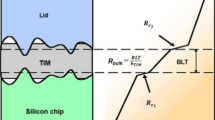Abstract
The limitation of the currently available thermal management method has put an ever serious challenge for computer chip designers. A liquid metal with low melting point around room temperature was recently identified as a powerful coolant of driving heat away because of its superior thermo-physical properties and the unique ability to be driven efficiently by a completely silent electromagnetic pump. However, the adoption of gallium, one of the best candidates as metal coolant so far, may cause serious corrosion to the structure materials and subsequently affect the performance or even dangerous running of the cooling system. To address this emerging critical issue, here the compatibility of gallium with four typical metal substrates (6063 Aluminum-Alloy, T2 Copper-Alloy, Anodic Coloring 6063 Aluminum-Alloy and 1Cr18Ni9 Stainless Steel) was comprehensively investigated in order to better understand the corrosion mechanisms and help find out the most suitable structure material for making a liquid metal cooling device. To grasp in detail the dynamic corrosion behavior, an image acquisition and contrasting method was developed. Moreover, corrosion morphology analyses were performed by means of scanning electron microscope (SEM). The chemical compositions of the corroded layers were evaluated using energy dispersive spectrometry (EDS). According to the experiments, it was found that, the corrosion of the 6063 Aluminum-Alloy was rather evident and serious under the temperature range for chip cooling. The loose corrosion product will not only have no protection for the inner substrate, but also accelerate the corrosion process. Compared to the 6063 Aluminum-Alloy, T2 Copper-Alloy showed a slow and general corrosion, but part of the corrosion product can shed from the substrate, which will accelerate corrosion action and may block the flowing channel. Anodic Coloring 6063 Aluminum-Alloy and 1Cr18Ni9 Stainless Steel were found to have excellent corrosion resistance among these four specimens. No evident corrosion phenomena were found under the examination of SEM and EDS when exposed for 30 days at the temperature of 60°C, which suggests their suitability as structure materials for the flow of liquid metal. However, as for the Anodic Coloring 6063 Aluminum-Alloy, surface treatment and protection are of vital importance. The present study is of significance for making a liquid metal chip cooling device which can actually be used in the future computer industry.
Similar content being viewed by others
References
A. Shakouri, Proc. IEEE 94, 1613 (2006)
Y.S. Tseng, H.H. Fu, T.C. Hung, B.S. Pei, Appl. Therm. Eng. 27, 1823 (2007)
R.C. Chu, R.E. Simons, M.J. Ellsworth, R.R. Schmidt, V. Cozzolino, IEEE Trans. Device Mater. Reliab. 4, 568 (2004)
M. Saini, R.L. Webb, IEEE Trans. Compon. Packag. Technol. 26, 71 (2003)
X.L. Xie, Y.L. He, W.Q. Tao, H.W. Yang, Appl. Therm. Eng. 28, 433 (2008)
R. Singh, A. Akbarzadeh, C. Dixon, M. Mochizuki, R.R. Riehl, IEEE Trans. Compon. Packag. Technol. 30, 42 (2007)
P. Wang, A. Bar-Cohen, J. Appl. Phys. 102, 034503 (2007)
K. Kordas, G. Toth, P. Moilanen, M. Kumpumaki, J. Vahakangas, A. Uusimaki, R. Vajtai, P.M. Ajayan, Appl. Phys. Lett. 90, 123105 (2007)
J. Liu, Y.X. Zhou, China Patent No. 021314195 (2002)
A. Miner, U. Ghoshal, Appl. Phys. Lett. 85, 506 (2004)
K.Q. Ma, J. Liu, J. Phys. D, Appl. Phys. 40, 4722 (2007)
K.Q. Ma, J. Liu, Frontiers Energy Power Eng. China 1, 384 (2007)
P.R. Luebbers, O.K. Chopra, in Sofe ’95—16th IEEE/Npss Symposium on Fusion Engineering, Vols. 1 and 2—Seeking a New Energy Era, ed. by G.H. Miley, et al. (New York, 1995), pp. 232–235
K.A. Narh, V.P. Dwivedi, J.M. Grow, A. Stana, W.Y. Shih, J. Mater. Sci. 33, 329 (1998)
X.D. Bai, Materials Corrosion and Control (Tsinghua University Press, Beijing, 2005), p. 490. (In Chinese)
S.X. Liu, P.J. Li, D.B. Zeng, Corros. Sci. Prot. Technol. 13, 275 (2001). (In Chinese)
Author information
Authors and Affiliations
Corresponding author
Rights and permissions
About this article
Cite this article
Deng, YG., Liu, J. Corrosion development between liquid gallium and four typical metal substrates used in chip cooling device. Appl. Phys. A 95, 907–915 (2009). https://doi.org/10.1007/s00339-009-5098-1
Received:
Accepted:
Published:
Issue Date:
DOI: https://doi.org/10.1007/s00339-009-5098-1




